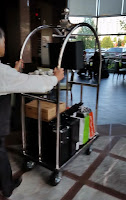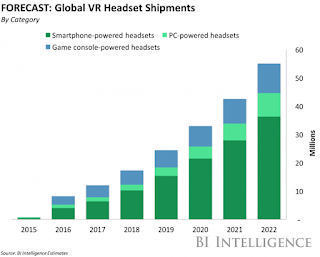 I'm just wrapping up this conference in Toronto and it's another week before we're back at it in class. This is a small conference where you get to meet and talk to many of the participants. By the end of the three days you're familiar with a lot of faces, which doesn't happen at the bigger events.
I'm just wrapping up this conference in Toronto and it's another week before we're back at it in class. This is a small conference where you get to meet and talk to many of the participants. By the end of the three days you're familiar with a lot of faces, which doesn't happen at the bigger events.I was invited to demonstrate virtual reality research my students and I have done in class over the past year. Bringing all the kit involved in setting up multiple VR sets is like bringing all you'd need to project a movie... in 1930. These are the heaviest, most awkward VR sets people will ever experience and it took a car load of tech to set up two headsets.
This 'state of the art' technology that is a pain to set up and far from perfect might seem like an odd choice to bring to a teacher technology focused conference. Where everyone else is showing off cloud based software tools or simple electronics, I'm here with this astonishingly complex and expensive technology that clearly isn't for everyone, but that's why I brought it.
If you'd have shown up at an education technology conference in 2008 with a touch screen tablet that could run apps, create digital media and replace 80% of the work you do on a desktop computer, you'd have looked a bit mad. Everyone there would wonder why you're showing off this stuff from Star Trek since it'll never be used in a classroom. Eighteen months later Apple would produce the first ipad and everyone's mind would change.
When I first tried the latest evolution in virtual reality last spring I was surprised at how accessible it had become. From bespoke systems that cost tens of thousands of dollars we suddenly saw Oculus and then HTC Vive appear with thousand dollar headsets that would run on a decent desktop computer. It's not often you see an evolutionary leap that drastic and effective in computer technology (think ipad levels of advancement over a PDA). The prices have since dropped again to under $600.
Bringing VR as it is now (big, awkward, complex) to an educational conference on technology was an opportunity to show people where we'll be in the next five years. Heavy, hot, wired and expensive VR sets with lots of setup and complication won't be how many people first experience VR, but it's important for educators to be ahead of mass adoption and think about how media is evolving so that we're able to effectively harness it when that ipad moment happens.
VR is evolving so rapidly that it has reached a kind of critical mass with research and development support. Money that used to go elsewhere is being focused on VR development which is further accelerating an already hot technology sector. This means you'll be using VR in your classroom a lot sooner than you think. Wouldn't it be something if teachers knew something about it before that happens?
I had a lot of people walk up to the station and ask me what company I'm with, even though this was a Minds on Media event and that means it's run by teachers for teachers. There is a lot of subtext in the question. The assumption that I had to be some kind of engineer with a VR company comes from a place where teachers assume they aren't experts on tech, but many are and we should make a point of recognizing those skills as they are a key to improving technical fluency in Ontario education. The other assumption became apparent when people asked me how I could possibly have put this together in an Ontario classroom.
I'm lucky there. My school board makes a point of exploring emerging technologies with the Specialist High Skills Major program. Without that support my expertise as a former IT technician is wasted, but with that support we have an example of an Ontario classroom exploring the leading edge of emerging technologies. The first thing we did after figuring out how to get VR working (and this was a team effort with myself, our board IT department and my senior computer engineering students) was to begin building and setting up VR sets for other schools. This capacity building led to one of my students returning to his elementary school as a coop student and assisting them with their VR research which in turn led us to becoming an ICT SHSM program for the first time. There is a virtuous circle when we enable the technical skills of Ontario teachers and use it to actively engage with evolving educational technology rather than waiting for it to surprise us.
I tend to shy away from turn-key digital substitutions of existing class work. If it is relying on computers and networks you've introduced so much complication into something that achieves the same learning goal more simply that I don't bother. If a poster making session in class would do it, why bother going digital? But there are moments with technology where it offers you something so profoundly different from what you could do in an analog classroom that it begs you to use it. VR did that for us with an opportunity to build digital 3d models and design software for VRspace.
Running Tiltbrush for art teachers from elementary to senior high school always prompted the same result. Artists get excited by a new medium and this is that. If you've never sculpted with light before, you can in VR. Using something as immersive and tactile as VR is much better than explaining it. After explaining VR many asked me what the point of it was. After trying VR most of them were lit up by it, suddenly imagining all the possibilities, and that's what I was there for. I'm not selling you on a platform, or a company, or a carefully designed analog replacement, I'm offering you a glimpse into the future. If you left full of excitement at the possibilities, and pretty much everyone did, then my job was done.
VR offers 3d, immersive interaction with a digital world we've only been able to peer at through a 2d monitor before. This will change everything, again.
| Dozens of links and lots of information on how to get started in VR in your classroom, check it out! |




